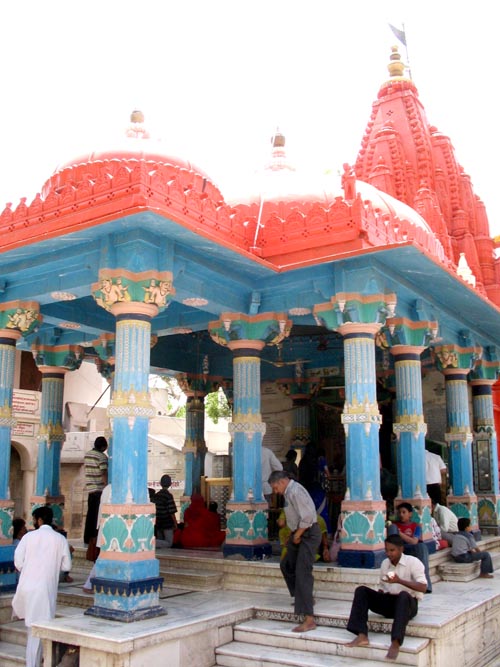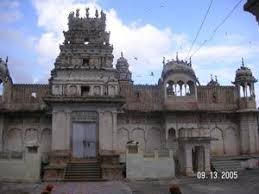

In Pushkaram, we have to worship Four important places. One is Pushkar lake. Second is temple of Brahma. Here, Brahma is in meditating pose. On one side of Brahma is Gayatri Devi and on the other side Savitri Devi, are gracing. There are Two temples Purana mandir and Naya mandir, in South Indian architecture and with poojas performed in Southern pattern. In Purana Mandir, Sri Venugopala, as a very large idol, is gracing, along with Consorts. On one side Sri Ranganatha, reclining, is gracing. On another side a huge idol of Swami Bhagavat Ramanuja is there. Next we see the reincarnation of Swami Ramanuja, Swami Manavala Mamunigal. All these are in Purana [Old] mandir. We can see the antiquty of the temple in its mantaps, gopurams and in prakaramas. From there we reach Naya [New] mandir. Here Sri Vaikuntanatha Swamy is gracing. There is a sannidhi for Swami Vedanta Desika, who has given us Tatparya Chandrika, commentary on Gita.

Pushkaram is famous for Brahma, Gayatri, Savitri and the lake. The Lord resides in water and when the water was Milky Ocean, He churned it, to get Nectar or amrut for the Devas. When same water was obstructing in reaching Sri Sita, the Lord got Sethu bridge constructed. Thus the Lord is worshiped as Water and as Bridge on water! Now, we will see the summary of Chapter 17. In Chapter 16, the Lord advised to do according to Shastras. Arjuna had a doubt. What if, one did, not according to Shastras, but sincerely and earnestly? This might be the doubt in many. Is there result for such actions? It need not be great, but at least a little. In mathematics exam, students expect some marks for the steps, even if answer was wrong! Arjuna raises this doubt [17.1]. He wanted to know that what was the reward for those, who violated Shastras, but did sincerely - would they get Sattva or Rajo or Tamo result? Sri Krishna was irritated at this quaetion! He had already stressed that every action should be in accordance with Shastras. So, doing sincerely, is secondary. He then, says that such actions in accordance with Shastras, have to be done sincerely. Thus, both the conditions - in accordance with Shastras and sincerity - are important. This is what the Lord says through out the Chapter. Swami Alavandar in his Gitartha Sangraha mentions as:
a´s¯astram.¯asuram.kr. tsnam.´s¯astr¯ıyam.gun.atah.pr. thak |
laks.an.am.´s¯astra siddhasya tridh¯a saptada´soditam || (21)
Those done, violating Shastras or done without sanction of Vedas, are all with Asura quality. But those done in accordance with Shastras, will vary according to the quality [sattvam, rajas and tamas] with which they are done. Also, such Shastra accepted actions would have to be done with the Three - OM, TAT and SAT. Why we should do anything according to Shastras? Because, they are as desired by the Lord. It is like rules and regulations, in any administration. Even in a republic, people have to abide by rules and regulations. Similarly, the Lord has prescribed certain rules and regulations for the people of this Universe. That is Shastra! For those abiding by Shastras, Three types are told by the Lord in this Chapter. Those with the Three qualities, differ in worship of deities, in performance certain yagnas, do certain Dhanams, perform some Tapas, eat certain type of food. Satva persons worship Sriman Narayana and other Devas [17.4]. Rajasa persons worship Yakshas and Rakshasas. Tamasa persons worship ghosts and manes. In 17.7, He lists the food eaten by people with various qualities. Sattvika food would grow happiness and satisfaction. It would provide good health, in the long run. Too much spicy would be rajasa food. Tamasa food are spoiled and over cooked food, without natural taste and with strong smell. In 17.20, He speaks of Dhanam. Sattvika donations are done at proper time to proper person, as prescribed and donated happily. If donations are done for publicity and fame, it is Rajasa dhanam. Tamasa dhanam is done carelessly and humiliating the recipient. We will now proceed to Kurukshetra, where we will complete Gita lectures, in a fitting way!
No comments:
Post a Comment